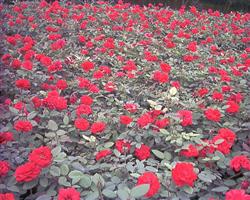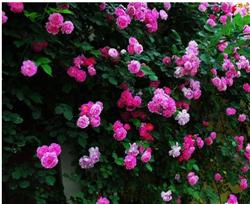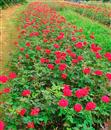How to plant Chinese rose?

How to plant Chinese rose? Please introduce in detail and guide the planting method of rose can refer to the following: wild rose or special rootstock used for grafting propagation as rootstock, grafting or budding method is used for grafting. The rootstocks were sown at the beginning of April of the first year and transplanted in April of the following year. The nursery bed should choose fertile and loose sandy soil with a row spacing of 20 × 80 cm, bud grafting in June and planting in the third spring. To prepare the soil, choose fertile, loose, rich in organic matter, well-drained sandy loam, use fully mature livestock manure as base fertilizer, apply 45000-60000 kg per hectare, and then carry out soil disinfection. The method is as follows: methyl bromide, 10 kg for every 100 square meters, covering the soil with plastic film for more than a week after treatment; cyanide, 7.5 litres for every 100 square meters, covering with plastic film for more than two weeks after treatment; dripping agent, 2.8 liters for every 100 square meters, after treatment, cover with film for more than two weeks. The method of border planting is adopted in scientific planting. The width of the border is 1 meter, the height is 10-15 cm, two rows are planted on each border, the large row spacing is 90-100 cm, the small row spacing is 30 cm, the plant spacing is 20 cm, the density is 6-8 plants per square meter, and the width of the walkway between the borders is 20-30 cm. Adjust the temperature and humidity in the solar greenhouse, the daytime temperature should be 20 ℃ ~ 25 ℃, the highest temperature should not exceed 28 ℃, the night temperature should be kept at 12 ℃ ~ 15 ℃, and the relative humidity should be 65% and 75%. Pay attention to ventilation. Rational fertilization rose like fertilizer, can be under the root topdressing, can also be foliar spraying potassium dihydrogen phosphate, urea, Gaomeishi, ferrous sulfate foliar fertilizer and so on. Give less, give diligently. Generally, liquid fertilizer is applied every 10 days, and compound fertilizer is applied in winter. Water management should be dry-watered and wet-drained. Spring seedlings should be watered and loosened after planting, and should be watered at the right time depending on the situation. The soil temperature is high in summer, so watering should be carried out after 5 pm. Rose is resistant to drought and afraid of stagnant water. when there is heavy rainfall, we should pay attention to drainage and often weed and loosen the soil. Pruning and pruning roses should be pruned before planting and buds should be removed in time after planting. When three or five strong branches grow, they begin to pick flowers. After that, the branches should be trimmed 3-5 times a year, and the branches should be arranged at any time, leaving 2-4 buds on each branch. Leave 1 cm on the bud when cutting, and cut diagonally to the other side of the branch. The cut should be smooth. There are two kinds of pruning: one is low pruning, that is, only two buds are left upward from the base of the branch, and the upper branch is cut off. This pruning method produces long and thick branches, large buds and good quality. Second, high pruning, more buds left in the lower part of the branches, more new branches and flowers, but short branches, small buds and poor quality. The above two pruning methods, used alternately in production, can control the plant height and make the rose maintain a longer growth cycle and higher production capacity. The grafted seedlings are renewed every 8 years or so. Coring when the new shoot grows to 15cm to 20cm, remove the top about 3cm, and still pick the heart twice to a certain length, until the number of main branches and lateral branches of the whole plant is enough to produce a large number of flowers. The purpose of heart picking is to adjust the plant shape at the initial stage and to control the flowering period after flowering. When the diameter of the flower bud reaches 10 to 13 mm, the place where the top of the branch reaches the second leaf can promote the florescence for about 7 days. Prevention and control of diseases and insect pests ventilation to reduce the incidence, elimination of burning virus branches, through high temperature for 4 weeks, can eliminate and reduce the virus in the body. The common diseases of rose are black spot, powdery mildew, rust, etc., which can be controlled by 80% mancozeb wettable powder or 50% benzoate wettable powder. 1000 times of fenitrothion can be used to control aphids, thrips, leaf rollers, beetles and other pests. Flower picking and grading rose should be cut when the temperature is low and the humidity is high. Generally, flowers are collected about 10 months after planting and are harvested when the buds bloom slightly (about 2 days before flowering). Cut branches should have 5 Internode spacing or longer length. Immediately after harvest, it should be inserted into the water and transported back to the workshop for classification, and every 10 branches should be tied into a bundle. Grading standard: the first-grade branch is 55cm long and 60cm long and the flowers are neat; the second-grade product is 45cm-54cm; the third-grade product is 35cm-44cm; the external product is less than 35cm. After packing in cellophane, cut the branches and insert them into the water. Fresh-keeping and storage cut rose flowers have a short shelf life and are not resistant to long-distance transportation. Treated with octadecylquinoline sulfate and stored in a cold storage of 3 ℃ ~ 4 ℃, it can be kept fresh for 3 days. If the cut rose is not on the market, it needs long-term storage and can be stored in a sealed cold storage with 1% oxygen and 5% carbon dioxide at a temperature of 0 ℃ ~ 1 ℃, which can be kept fresh for 20 to 30 days. Click to get more rose planting techniques click to get more flower planting techniques
- Prev

What method can make the rose blossom continuously?
What method can make the rose blossom continuously? Rose is a kind of flower that blooms frequently all the year round. It has a wide variety, bright colors and fragrant smell. It would be more desirable if it could blossom continuously. The monthly sex likes the growth environment with plenty of sunshine, good ventilation and fertile soil.
- Next

How to fertilize and manage rose planting?
How to fertilize and manage rose planting? Please give guidance to rose fertilization varies from season to season, 25% in summer and 12.5% in winter. All kinds of chemical fertilizers of nitrate nitrogen and ammonium nitrogen can be used, but urea should not be used, especially in clay soil, because urea will increase the pH value of the soil. Fertilize the rose.
Related
- Fuxing push coffee new agricultural production and marketing class: lack of small-scale processing plants
- Jujube rice field leisure farm deep ploughing Yilan for five years to create a space for organic food and play
- Nongyu Farm-A trial of organic papaya for brave women with advanced technology
- Four points for attention in the prevention and control of diseases and insect pests of edible fungi
- How to add nutrient solution to Edible Fungi
- Is there any good way to control edible fungus mites?
- Open Inoculation Technology of Edible Fungi
- Is there any clever way to use fertilizer for edible fungus in winter?
- What agents are used to kill the pathogens of edible fungi in the mushroom shed?
- Rapid drying of Edible Fungi

